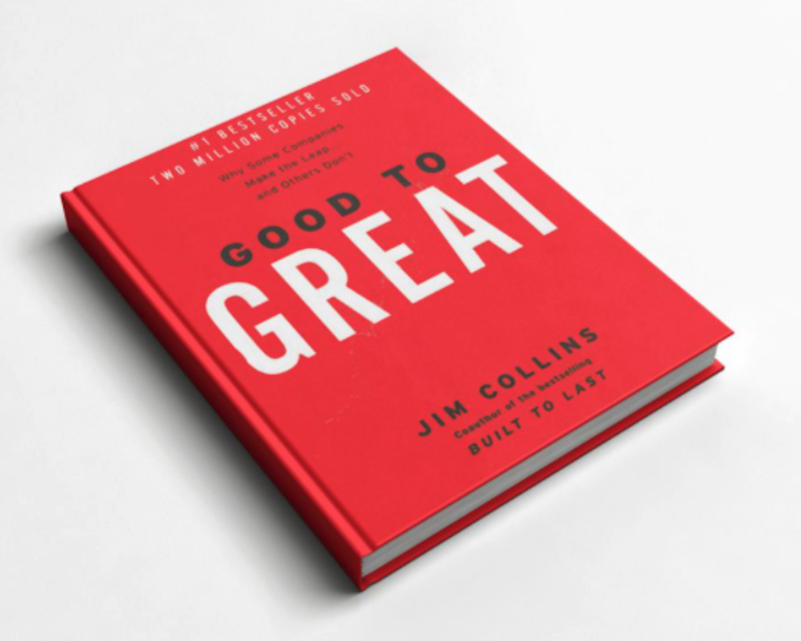Jim Collins‘ books – where do I start? They’re some of my favourite management books of all time. You must read them – particularly if you’re a CEO looking to scale your business. They’re just too important to ignore. Start with ‘Good to Great’. This seminal book had a profound influence on me. To say it transformed my way of thinking is an understatement. Good to Great should be part of your essential reading list.
I first read it when it was published in 2001 and shortly after completing my MBA. There I was as a new Managing Director of a tech start-up, Rackspace, facing challenges and looking for tools. ‘Good to Great’ formed the foundation for all of these. The gems Collins and his research team shared proved to be actionable during my time as MD at Rackspace, ITLab and Peer1. Now they form the basis of my coaching practice.
Summary of Good to Great: What can you learn from Jim Collins’ Book?
Good to Great is a seminal work that explores the transformation of ordinary companies into exceptional ones. Analysing 28 companies over 30 years, the book provides timeless insights into achieving business excellence. This summary emphasises the enduring relevance of its transformative principles, offering invaluable guidance to entrepreneurs and professionals alike.
If there was any criticism of Good to Great when it first came out, it was that this longitudinal study of what made companies great focused on larger organisations. In response, Jim went away and wrote Great by Choice looking at smaller businesses who, as they’d scaled up, decided to be excellent. What’s fascinating is he concluded there was little difference when he compared and contrasted the larger companies with the smaller ones. All the good to great companies share the same characteristics.
So what were these characteristics? And what are the main lessons from Good to Great?
1. Good to Great companies have Level 5 Leadership
In Good to Great, Collins describes how he debated with his research team on the nature of leadership in good to great companies. There was something about their CEOs that was different. Eventually, they settled on the characteristics of humility and a drive to do the right thing for the company’s good, not themselves. Collins defined the different levels, with Level 5 leadership at the peak.
Level 5 Leadership is not just about leading the business. This form of leadership melds together the ferocity of professional will with the humility of personal character. Collins emphasises that it’s not charisma but rather the blend of determination and humility that defines this type of leadership. Embracing the principles of Level 5 Leadership can be the difference between fleeting success and enduring excellence.
From my experience, he was bang on target. Of the entrepreneurs I coach, the most successful ones share a complete lack of arrogance. They’re humble people – understanding that they don’t know everything. And, without fail, they’re driven to do the right thing by their employees, shareholders and customers.
I was chatting to a client who demonstrated Level 5 leadership only this morning. Yes – his business model was proving successful, and growth was rapid. But a greater reward lay in the opportunity to change more lives for him. He saw his business as a vehicle to do this for his employees and customers. It was the same when I think about my time as MD of Peer1. The numbers were great. We scaled up from zero to £30 million in five years. But my satisfaction came from the profound changes we made to the lives of those who came to work with us. Where this got them. Our business was a slingshot for so many people, propelling them to bigger, better, greater things. It gives me goosebumps just thinking about it! I’m so proud of this personal impact. All those people are on their personal good to great journey.
2. First Who – Get the right people on the bus

This is the most important of all the lessons from Good To Great. If you don’t take anything else away, this is the one thing always to remember. Nothing is more important to a business than the talent it employs – what Jim Collins calls ‘getting the right people on the bus‘.
In all of his work, Collins emphasises the importance of ‘getting the right people on the bus.’ It’s not merely about filling seats; it’s about ensuring each seat is occupied by someone who wants to drive the organisation forward. Before plotting the direction or setting the strategy, the vital first step is assembling a team that embodies the ethos and vision of the enterprise. It’s a principle that underscores the role of human capital as the bedrock of transformative success.
I talk about this a hell of a lot in my coaching. But when I re-read Good to Great at Christmas, I realised I needed to do it even more. In fact, I need to be almost maniacal about finding the right people. Maybe I’ve not been direct enough with some of our clients. I know from experience how difficult it is to do the work necessary to achieve an executive team of A-Players. When I look back at my Rackspace and Peer 1 days, we certainly had some of the right people on the bus. But we never got close to the magic target of 80 – 90% A-Players. And that’s despite the rigorous recruitment systems we introduced (at Rackspace, we joked that it was harder to get a job with us than get into Oxford. Great to see they still use this analogy in the US, saying it’s harder to get into Harvard).
So this year, I’ll focus on this even more. We’ll use Patrick Lencioni’s Working Genius tool along with Gallup Strengths – the aim is to give entrepreneurs and leadership teams the vocabulary to have difficult conversations and hold each other accountable. We’ll work on trust and productive conflict. People need to learn this stuff through experience. That’s where the value of OKRs comes in. I help clients build a cultural and behavioural framework and then use OKRs to create performance measurements. It’s where these two things intersect when you find your A-Players.
In Good to Great, Collins points out that you need the right people on the bus before you work out where you want it to go. So it’s fundamental. I’ve worked with clients who’ve said they want to make this transition but found it too difficult. They weren’t ready to replace colleagues or move them to other roles. But if you don’t do this, you’ll have the wrong people and culture. Your B-Players will set the behavioural standards, and you’ll build your business around them. You need A-Players to set the tone.
3. To go from good to great, companies need to confront the brutal facts
Collins describes the experience of Admiral James Stockdale – the highest-ranked American prisoner-of-war in the Vietnam War – in Good to Great, calling it ‘the Stockdale Paradox’.
Stockdale was locked up for a long time – over eight years. Many of his fellow prisoners gave up the will to live during this time. They were the optimists. The ones who said we’ll be out by Christmas or Easter or their next birthday eventually ran out of hope. In contrast, Stockdale lived day to day, accepting the brutal reality of his situation. But he never lost faith that he would make it out alive, and it would become the defining event of his life.
Collins and his research illustrate the need to confront the brutal truths head-on. This isn’t about pessimism but a call for radical candour. It’s about facing the future, armed with an unwavering resolve to face the facts, however stark they may be. Collins suggests great companies can evidence this unwavering commitment to reality. Ignorance or denial is the antithesis of progress. Progress can only begin with truth, however unpleasant.
Despite the circumstances you’re going through, if you have a clear BHAG, you can hold fast to that mission. Your company can make the leap. Trust that you will reach your destination but accept whatever life throws at you. So often, organisations are in denial about what’s happening around them. With hindsight, I can see that most of my time at Peer 1, we were in denial about the impact of the Cloud on our business, or more specifically, AWS. Perhaps we’d have been in a different place if we’d confronted this.
4. The Hedgehog Concept

The Three Circles of The Hedgehog
Why do some companies make the leap? What lights your fire? What could your business be the best in the world at? And what makes you money – your profit per x? These are the three circles of the ‘Hedgehog Concept’. According to Collins, where they intersect is where you’ll find your BHAG or mission. Going through this process forces you to think, who is my customer, and what’s their problem? And it is a great process that forces you to define your sandbox. Powerful stuff!
Collins ‘Hedgehog Concept’ is a principle that champions the synthesis of passion, proficiency, and profitability. Collins artfully draws from the parable of the cunning fox and the singularly focused hedgehog. Where businesses often scatter their efforts, trying to master all, the brilliance lies in discerning that intersection where one’s true passion meets what one can be best at and where the economic engine thrives. It’s not about being a jack-of-all-trades but rather mastering that core niche that drives sustainable success. The ‘Hedgehog Concept’ is a clarion call to cultivate depth, focus, and unwavering clarity in your organisational.
All good in theory, but when I ask clients what they could be best in the world at, I’m often met with blank faces. Even worse, laughter! Often, they’re selling lots of stuff to lots of different customers. Finding one to focus on is hard. Discussion can go round and round. Similarly, when I ask them what they’re passionate about, a common response is, ‘Er – nothing’ (massive face-palm!) It brings me back to having the right people. If your team finds it hard to be passionate or care enough about something, they may not be the right people. This is important. They need to evangelise your mission.
When teams get the Hedgehog Concept right, it’s transformational. Take our client, Excelsior Multi Academy Trust. Their BHAG is to be world-famous for innovation in education. This transformed how they wrote job ads, which transformed the volume and quality of CVs they received and the quality of teachers they were hiring. They’re starting to impact the wider educational arena in Birmingham. What an absolute joy for me as their coach. It’s inspirational to witness people taking the frameworks I offer and using them with such an impact.
5. Good to Great companies have a culture of discipline
Jim Collins uses the expression ‘Rinsing out the cottage cheese’ to describe the importance of good company and a culture of discipline in Good to Great. It seems a strange use of words until you understand he’s referring to athlete David Scott. During a period where Scott won six Ironman triathlons, he rinsed his cottage cheese to eliminate any excess fat. Whether this helped or not, this small action showed Scott’s disciplined thought, disciplined action, focus and commitment to being the best.
It smacks of obsession with marginal gains – the 1% that will make all the difference to performance. A constant drive to be the best. Making steady, consistent progress towards a goal. This can only come from a business culture of discipline and a constant, almost restless curiosity.
In his compelling narratives on great companies and management strategy, Collins suggests the ‘Culture of Discipline‘ as a cornerstone of enduring greatness. It’s not about bureaucratic rigidity or stifling creativity but more instilling a framework where disciplined people engage in disciplined thought, leading to disciplined action. Collins finds evidence that when an organisation empowers self-driven individuals with a clear vision, the interplay of entrepreneurial spirit with diligent consistency emerges.
It makes me twitch when I discuss business books with a prospective client, and they tell me they don’t read. I don’t know where to go next. How do you plan to go from good to great if you can’t find time to discover how others have already done it? This demonstrates a lack of curiosity, determination and discipline. There is always time to read and improve your knowledge. Where would I be without Jim Collins, Verne Harnish, and Patrick Lencioni? Who would have given me the frameworks on which I’ve built success for my teams? Returning to Level 5 leadership, there’s a link between humility and reading. Successful CEOs will have the discipline to read at least 12 books a year. It’s why their companies make the leap and why we run our book club here at Monkhouse & Company.
6. Technology accelerators move companies from Good to Great
According to Collins, good to great companies think differently about technology. Instead, they avoid fads and focus solely on technology that can accelerate momentum in the Hedgehog Concept.
In an older piece of research, McKinsey found that 17 – 20% of companies that do IT projects well go on to invest in more IT. But the opposite is also true – if there’s a track record of failure, it puts companies off further IT investment leading to divergence over time. Digital transformation is difficult, no question. But it’s not impossible. If your business fails at IT, you must change your people, suppliers, or tools. But don’t stop investing. You can bet one or more of your competitors will use technology well.
7. Good to Great companies build a flywheel of momentum

Transformation doesn’t happen in one fell swoop. There’s no single big action, or killer innovation, or miracle moment. Instead, as Collins describes in Good to Great, it’s more like relentlessly pushing a giant, heavy flywheel. Turn by slow turn, you gradually build momentum until, at last, it starts to spin by itself.
Collins’ masterful analogy of the ‘Flywheel’ and the ‘Doom Loop’ encapsulates the rhythm of sustained success versus the turbulence of inconsistent efforts. The ‘Flywheel’ depicts the gradual momentum built by organisations that make consistent, strategic pushes in one direction. It’s a cumulative effect of every push, every choice, every strategy, all driving towards business greatness. Conversely, the ‘Doom Loop’ symbolises those who, lacking patience and clarity, jump from one new direction or trend to another, seeking instant results. In their haste, they never allow the flywheel’s momentum to build up.
I often discuss this idea with new clients and suggest we look for flywheels in their business. This sums up what I do for a few people for a living – uncovering the flywheel of their business model. Yes – they have a plan containing their numeric hopes and dreams. But to get there, they need a model that begins to spin for itself. Vision, core customer, culture, innovation – once properly calibrated, everything interlinks to build the momentum you need for growth.

